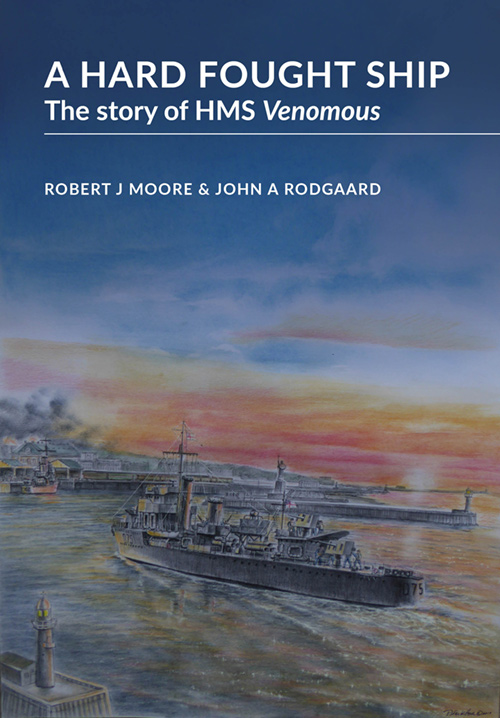






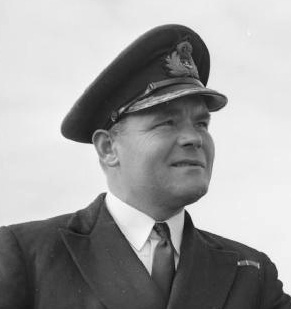
 Lt Cdr Donald G.F.W. Macintyre RN
(on left) was fourteen when he joined the Royal Navy as a cadet at
Britannia Royal Navy College, Dartmouth, in 1917 and was not impressed
when he was given command of HMS Venomous,
an elderly V&W Class destroyer which had been laid up since 1930 at
Chatham and Rosyth. He joined his 'new' ship on the 31 July 1939 in
time to be presented to the King at the Review of the Reserve Fleet in
Weymouth Bay on the 9 August but spent four uneventful months escorting
troop carriers to Cherbourg, Brest and Le Havre before handing over to
John McBeath. Macintyre went on to become one of the the most successful escort group commanders in the Battle of the Atlantic and wrote many books on the war at sea including his autobiography U-boat Killer (1956).
Lt Cdr Donald G.F.W. Macintyre RN
(on left) was fourteen when he joined the Royal Navy as a cadet at
Britannia Royal Navy College, Dartmouth, in 1917 and was not impressed
when he was given command of HMS Venomous,
an elderly V&W Class destroyer which had been laid up since 1930 at
Chatham and Rosyth. He joined his 'new' ship on the 31 July 1939 in
time to be presented to the King at the Review of the Reserve Fleet in
Weymouth Bay on the 9 August but spent four uneventful months escorting
troop carriers to Cherbourg, Brest and Le Havre before handing over to
John McBeath. Macintyre went on to become one of the the most successful escort group commanders in the Battle of the Atlantic and wrote many books on the war at sea including his autobiography U-boat Killer (1956).
Lt Cdr John E.H. McBeath RN
(right) was born in the Transvaal, South Africa, in 1907, and joined
the Royal Navy at Simonstown as a fourteen year old boy sailor in 1921. He served on HMS Hood as OD and AB for three years and was promoted to Warrant Officer rank in 1928. McBeath was CO of Venomous in May and June 1940, the most dramatic period in her history when the Welsh and Irish Guards were evacuated from
Boulogne under close fire from enemy tanks and shore batteries and the
BEF from the beaches and north mole of Dunkirk. After four months on
the Harwich patrol Venomous was ordered to the Clyde and escorted the elderly carriers, HMS Argus and HMS Furious, with fighter reinforcements for the besieged island of Malta to Gibraltar. Soon after Venomous was
transferred to Western Approaches Command and joined the First Escort
Group at Londonderry John McBeath fell ill and was
replaced as CO by Cdr H. Pitcairn RN on Christmas Eve 1940. McBeath went on to command HMS Oribi as part of the 17
Destroyer Flotilla escorting Arctic Convoys to northern Russia. After
the war he achieved Flag rank as Rear Admiral and after retirement in
1955 was Honorary Commodore of the Sea Cadet Corps and High Sheriff of
Surrey.
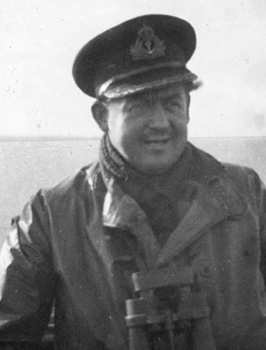
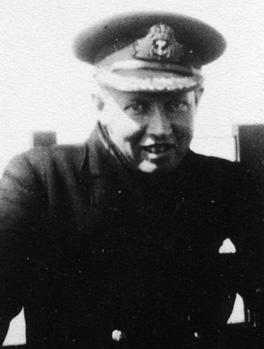 Cdr Harold P. Henderson RN (on left) was a flamboyant officer who had served on ships from battleships (HMS Malaya) to gunboats (HMS Dwarf)
but may have first made his mark when appointed Flag Lieutenant to the
Rear-Admiral in charge Gibraltar in 1926 and the CiC East Indies in
1929. In 1939 he was at HMS President
and in May 1940 was sent to Dunkirk as British Naval liaison Officer to
assist Captain William Tennant RN, the SNO Dunkirk, in the evacuation
of the troops. Venomous struck a mine at the mouth of the Mersey on the 30 December, six days after Henderson took over as CO, and was under repair at Birkenhead until the end of February 1941. HMS Venomous and
the First Escort Group at Londonderry escorted Atlantic convoys to
Havelfjord in Iceland, and after refueling met incoming convoys. He was
a popular CO and the Wardroom held a party when Cdr Hugh Falcon-Steward
(on right) took over on the 2 July 1941. Cdr H.P. Henderson commanded the
destroyer HMS Harvester and the destroyer depot ship HMS Philocretes before becoming CO of HMS Jervis and Captain (D) of the 25 Destroyer Flotilla. On the 23 January 1944 the bow of Jervis was
blown off by a radio controlled glide bomb at the Anzio landings and
Henderson swopped ships with Lt Cdr Roger P. Hill RN in HMS Grenville, a man with a reputation for evading glide bombs and was lambasted in his brilliant wartime memoir, Destroyer Captain. After the war Henderson was senior officer of the Reserve Fleet at Portsmouth and ended his career as naval attache, Cairo.
Cdr Harold P. Henderson RN (on left) was a flamboyant officer who had served on ships from battleships (HMS Malaya) to gunboats (HMS Dwarf)
but may have first made his mark when appointed Flag Lieutenant to the
Rear-Admiral in charge Gibraltar in 1926 and the CiC East Indies in
1929. In 1939 he was at HMS President
and in May 1940 was sent to Dunkirk as British Naval liaison Officer to
assist Captain William Tennant RN, the SNO Dunkirk, in the evacuation
of the troops. Venomous struck a mine at the mouth of the Mersey on the 30 December, six days after Henderson took over as CO, and was under repair at Birkenhead until the end of February 1941. HMS Venomous and
the First Escort Group at Londonderry escorted Atlantic convoys to
Havelfjord in Iceland, and after refueling met incoming convoys. He was
a popular CO and the Wardroom held a party when Cdr Hugh Falcon-Steward
(on right) took over on the 2 July 1941. Cdr H.P. Henderson commanded the
destroyer HMS Harvester and the destroyer depot ship HMS Philocretes before becoming CO of HMS Jervis and Captain (D) of the 25 Destroyer Flotilla. On the 23 January 1944 the bow of Jervis was
blown off by a radio controlled glide bomb at the Anzio landings and
Henderson swopped ships with Lt Cdr Roger P. Hill RN in HMS Grenville, a man with a reputation for evading glide bombs and was lambasted in his brilliant wartime memoir, Destroyer Captain. After the war Henderson was senior officer of the Reserve Fleet at Portsmouth and ended his career as naval attache, Cairo.
Cdr Hugh W. Falcon-Steward RN (right) was an anti-submarine specialist who had been on the staff of HMS Osprey,
the anti-submarine school at Portland in 1933 and then successively
Anti-Submarine Officer for the 5th, 19th and 4th Destroyer Flotillas
before taking up a new post at HMS Osprey
in 1938. He was far more formal in his manner than Henderson and could
be stern with young officers he suspected of not taking their duties
seriously. A week after taking command Venomous broke down south of Iceland and was towed 200 miles by HMS Sabre into Havelfjord for repairs alongside the destroyer depot ship, HMS Hecla. Despite a refit at Derry in August Venomous
continued to have problems with its engine while escorting convoys to
Iceland and, occasionally, to Halifax in Nova Scotia. While escorting
the Loch Ewe section of Convoy OS.35 in poor visibility on the evening
of the 11 November 1941 Venomous collided with the flotilla leader, HMS Keppell, commanded by Cdr J.E. Broome RN. HMS Venomous
was towed back to Loch Ewe for emergency repairs and from there to the
Clyde. Falcon-Steward was criticised by the Board of Enquiry for his
failure to use his primitive Type 286 RDF radar. While Venomous
was under repair and having a major refit at Troon Falcon-Steward was
posted to CiC Western Approaches to conduct a course on anti-submarine
tactics at the end of February 1942 and Lord Teynham took over as CO.
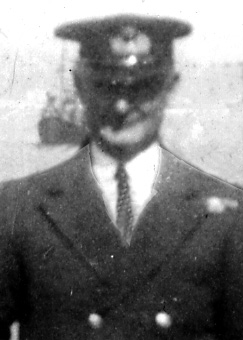
 Lord Teynham, Cdr Christopher J.H. Roper-Curzon RN was photographed on the deck of HMS Venomous
(left) while she was under repair at Troon. He was born in 1896 and
served in the Great War as a staff Signal Officer with the Grand Fleet
but left the service in 1918 and succeeded to the title on the death of
his father in 1936. He was recalled in 1939 and appointed as CO of HMS Cambletown in October 1941. Cambletown,
an elderly obsolete destroyer, was chosen to ram and blow up the dry
dock at St Nazaire but it was thought that Lord Teynham lacked
sufficient experience as CO of a destroyer and his capture would be a
propaganda coup for the Germans. He was posted to HMS Venomous
at Troon and the St Nazaire raid took place on the 28 March with Lt Cdr
S.H. Beattie RN as the CO. Falcon-Steward resumed command of Venomous in April and Lord Teynham was appointed CO of HMS Amazon. In
June 1944 he was Captain of the minesweepers for the British area of
the Normandy landings when through failure of a junior officer to
report a decision to reroute the flotilla two of the minesweepers were
sunk by friendly fire. Lord Teynham was court-martialled but acquitted.
At the end of the war he was appointed NOIC (Naval Officer in Command)
Kristiansand and may have influenced the decision to select HMS Venomous for this much sought after mission.
Lord Teynham, Cdr Christopher J.H. Roper-Curzon RN was photographed on the deck of HMS Venomous
(left) while she was under repair at Troon. He was born in 1896 and
served in the Great War as a staff Signal Officer with the Grand Fleet
but left the service in 1918 and succeeded to the title on the death of
his father in 1936. He was recalled in 1939 and appointed as CO of HMS Cambletown in October 1941. Cambletown,
an elderly obsolete destroyer, was chosen to ram and blow up the dry
dock at St Nazaire but it was thought that Lord Teynham lacked
sufficient experience as CO of a destroyer and his capture would be a
propaganda coup for the Germans. He was posted to HMS Venomous
at Troon and the St Nazaire raid took place on the 28 March with Lt Cdr
S.H. Beattie RN as the CO. Falcon-Steward resumed command of Venomous in April and Lord Teynham was appointed CO of HMS Amazon. In
June 1944 he was Captain of the minesweepers for the British area of
the Normandy landings when through failure of a junior officer to
report a decision to reroute the flotilla two of the minesweepers were
sunk by friendly fire. Lord Teynham was court-martialled but acquitted.
At the end of the war he was appointed NOIC (Naval Officer in Command)
Kristiansand and may have influenced the decision to select HMS Venomous for this much sought after mission.
Cdr Hugh W. Falcon-Steward RN
(on right above) resumed command of a very different ship from the one he left in
February. 'A' Gun had been replaced by the mortar throwing Hedgehog
anti-submarine weapon and the Type 286 RDF with the improved Type 272M
with rotating aerial but it remained a twin boiler short range escort
(SRE) unable to cross the Atlantic to Canada without refueling. The ship's company and officers were all new. HMS Venomous
escorted Arctic Convoy PQ.15 to Murmansk and returned to Londonderry
via the Clyde with QP.12 on the 3 June. Despite continuing engine
problems Venomous was part of the escort for Convoy WS.21S to reinforce the defence of Malta. As HMS Furious flew off its Spitfires she witnessed the torpedoing of the carrier HMS Eagle and took 500 survivors to Gibraltar. On the 21 October 1942 Falcon-Steward on Venomous was the senior officer of the escort for Convoy KX.4A, part of Operation Torch, the landings in North Africa. At Gibraltar Venomous and HMS Marne were sent to meet the two destroyer depot ships, HMS Hecla and HMS Vindictive, and escort them to the invasion beaches. The events of the night of 11 - 12 November when HMS Hecla
was torpedoed five times and Falcon-Steward rescued 500 men while
fighting the attacking U-boat before limping into Casablanca hours
after its capture by American forces are described in A Hard Fought Ship
and elsewhere on this web site. On the 18 December 1942 Falcon-Steward
was succeeded as CO by Cdr D.H. Maitland-MacMacgill-Crichton RN. He
became Staff Officer for Tactics to Admiral Max Horton, the newly
appointed CiC of Western Approaches, at HMS Eagret, Liverpool, and contributed to the winning of the Battle of the Atlantic (photographed on right, 10 February 1945).
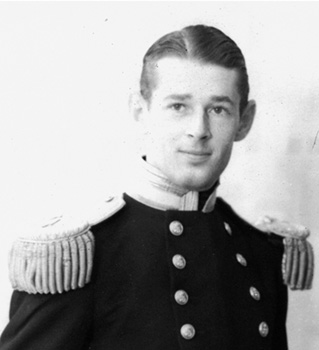 Cdr David H. Maitland-Makgill-Crichton RN,
the son of a Lt Cdr James H. Maitland-Makgill-Crichton RN, was brought
up in England by his South African Mother when his parents divorced and
his father emigrated to Australia. He went to Dartmouth in 1924 and
then served for three years on two of the Navy's big ships, the
battleship, HMS Resolution and the cruiser HMS Enterprise, and in 1930 was a Sub Lt on the Royal Yacht, The Victoria and Albert. He was First Lieutenant on the destroyer, HMS Express, at Dunkirk and was awarded the DSC. His Captain was killed two weeks later when Express
hit a mine off the Dutch coast and lost its bows. Crichton took command
and brought her back to port stern first navigating by the stars. He
was appointed CO of HMS Boreas in November 1940 and of HMS Ithuriel in February 1942 and was awarded the DSO in June for his part in Operation Harpoon, a convoy to Malta. On the 12 August Ithuriel forced the Italian submarine, Cobalto,
to the surface and then sank it by ramming, a spectacular sinking not
appreciated by his senior officer who thought the Italian sub was
finished and there was no need to risk his ship by ramming. After repairs at Liverpool and Portsmouth Ithuriel returned
to the Mediterranean in time for the landings in Algeria but on the 27
November 1942 was so badly damaged by bombing at Bone that she was
beyond repair. The appointment of this senior officer as CO of the
elderly V&W Class destroyer, HMS Venomous,
may have been due to plans to reinforce her bow with concrete, pack her
with explosives and ram the drydock of a French Vichy port in north
Africa, an operation
planned but canceled. His officers respected his expertise at ship
handling but sensed he thought himself too good for Venomous
but the men admired "four gun Crichton" and "would do anything for
him". After two comparatively uneventful months he was replaced as CO
by Lt Henry D. Durell RN on the 16 February 1943. For the rest of the war he was on the staff of the CiC Levant, HMS Nile,
the RN shore base in Alexandria. He had a natural talent for languages,
able to master one a year and eventually speaking forty. The Navy made
good use of this rare ability in Egypt and during the postwar years in
London and Scotland where he was Head of the Joint Services School for Linguists (JSSL) at Crail in Fife.
Cdr David H. Maitland-Makgill-Crichton RN,
the son of a Lt Cdr James H. Maitland-Makgill-Crichton RN, was brought
up in England by his South African Mother when his parents divorced and
his father emigrated to Australia. He went to Dartmouth in 1924 and
then served for three years on two of the Navy's big ships, the
battleship, HMS Resolution and the cruiser HMS Enterprise, and in 1930 was a Sub Lt on the Royal Yacht, The Victoria and Albert. He was First Lieutenant on the destroyer, HMS Express, at Dunkirk and was awarded the DSC. His Captain was killed two weeks later when Express
hit a mine off the Dutch coast and lost its bows. Crichton took command
and brought her back to port stern first navigating by the stars. He
was appointed CO of HMS Boreas in November 1940 and of HMS Ithuriel in February 1942 and was awarded the DSO in June for his part in Operation Harpoon, a convoy to Malta. On the 12 August Ithuriel forced the Italian submarine, Cobalto,
to the surface and then sank it by ramming, a spectacular sinking not
appreciated by his senior officer who thought the Italian sub was
finished and there was no need to risk his ship by ramming. After repairs at Liverpool and Portsmouth Ithuriel returned
to the Mediterranean in time for the landings in Algeria but on the 27
November 1942 was so badly damaged by bombing at Bone that she was
beyond repair. The appointment of this senior officer as CO of the
elderly V&W Class destroyer, HMS Venomous,
may have been due to plans to reinforce her bow with concrete, pack her
with explosives and ram the drydock of a French Vichy port in north
Africa, an operation
planned but canceled. His officers respected his expertise at ship
handling but sensed he thought himself too good for Venomous
but the men admired "four gun Crichton" and "would do anything for
him". After two comparatively uneventful months he was replaced as CO
by Lt Henry D. Durell RN on the 16 February 1943. For the rest of the war he was on the staff of the CiC Levant, HMS Nile,
the RN shore base in Alexandria. He had a natural talent for languages,
able to master one a year and eventually speaking forty. The Navy made
good use of this rare ability in Egypt and during the postwar years in
London and Scotland where he was Head of the Joint Services School for Linguists (JSSL) at Crail in Fife.
 Lt Henry D. Durell RN
(on right) was the exact opposite of the former CO, a senior lieutenant
and a modest unassuming man popular in the Wardroom but thought by his
men to be a bit of a comedown from his predecessor. His maternal
grandfather was Admiral of the Fleet the Hon. Sir Charles C.J.B.
Elliot, KCB but he was educated at the Nautical College, Pangbourne, a
boarding school which prepared its pupils for service in the Merchant
Navy. He became Chief Cadet Captain and received a commission as
Midshipman RNR. He joined the New Zealand Shipping Company but during
his training in the Royal Naval Reserve he served in the battleship
HMS Valiant and two V&W Class destroyers, Westcott and Vanoc
and in 1938 was given a permanent regular commission in the RN. When
war was declared he was a lieutenant on the battleship, HMS Rodney. In November 1939 he was appointed 1st Lt on the Tribal Class destroyer HMS Tartar
and took part in the evacuation of Norway, the expeditions to the
Lofoten Islands and Spitzbergen, Arctic convoys and the sinking of the Bismarck. When HMS Mashona was sunk the survivors were rescued by HMS Tartar.
On transference to the Mediterranean he participated in the Malta
convoys. Lt. Durell was mentioned in despatches and in February 1943
he was appointed to command HMS Venomous,
escorting the first through convoy from Gibraltar to Alexandria as far
as Tripoli and the troop ships from Alex to the invasion of Sicily,
Operation Husky.
Major defects in the engine room made an immediate return to Britain
essential and on arrival at Falmouth on the 20 October Durell and most
of the ship's company left. In December 1943 he was given the command
of HMS Isis and took part in the operations off the Anzio beach-head. After returning to England HMS Isis took part in Operation Neptune,
the D-Day landings on the Normandy beaches. Henry Durell was promoted
to the rank of Lieutenant-Commander on 14 July 1944 (his 32nd birthday) but six days later Isis
was sunk when she detonated a mine while patrolling off the Normandy
coast with the loss of her commander and the greater part of her
complement. His parents were instrumental in establishing a memorial in
Portsmouth Cathedral to the 155 officers and men who died. His widow
was left to raise their one year old son. Lt Cdr Henry D. Durell RN was
the only one of the nine wartime commanders of HMS Venomous to be killed in action.
Lt Henry D. Durell RN
(on right) was the exact opposite of the former CO, a senior lieutenant
and a modest unassuming man popular in the Wardroom but thought by his
men to be a bit of a comedown from his predecessor. His maternal
grandfather was Admiral of the Fleet the Hon. Sir Charles C.J.B.
Elliot, KCB but he was educated at the Nautical College, Pangbourne, a
boarding school which prepared its pupils for service in the Merchant
Navy. He became Chief Cadet Captain and received a commission as
Midshipman RNR. He joined the New Zealand Shipping Company but during
his training in the Royal Naval Reserve he served in the battleship
HMS Valiant and two V&W Class destroyers, Westcott and Vanoc
and in 1938 was given a permanent regular commission in the RN. When
war was declared he was a lieutenant on the battleship, HMS Rodney. In November 1939 he was appointed 1st Lt on the Tribal Class destroyer HMS Tartar
and took part in the evacuation of Norway, the expeditions to the
Lofoten Islands and Spitzbergen, Arctic convoys and the sinking of the Bismarck. When HMS Mashona was sunk the survivors were rescued by HMS Tartar.
On transference to the Mediterranean he participated in the Malta
convoys. Lt. Durell was mentioned in despatches and in February 1943
he was appointed to command HMS Venomous,
escorting the first through convoy from Gibraltar to Alexandria as far
as Tripoli and the troop ships from Alex to the invasion of Sicily,
Operation Husky.
Major defects in the engine room made an immediate return to Britain
essential and on arrival at Falmouth on the 20 October Durell and most
of the ship's company left. In December 1943 he was given the command
of HMS Isis and took part in the operations off the Anzio beach-head. After returning to England HMS Isis took part in Operation Neptune,
the D-Day landings on the Normandy beaches. Henry Durell was promoted
to the rank of Lieutenant-Commander on 14 July 1944 (his 32nd birthday) but six days later Isis
was sunk when she detonated a mine while patrolling off the Normandy
coast with the loss of her commander and the greater part of her
complement. His parents were instrumental in establishing a memorial in
Portsmouth Cathedral to the 155 officers and men who died. His widow
was left to raise their one year old son. Lt Cdr Henry D. Durell RN was
the only one of the nine wartime commanders of HMS Venomous to be killed in action.
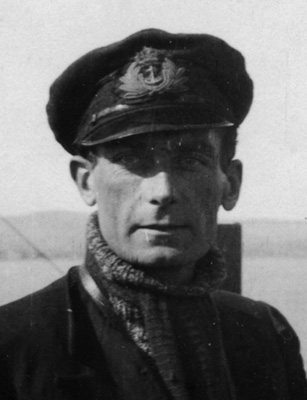 Lt Cdr A. Derek A. Lawson RNVR (1907 - 84) Venomous
had no future as a fighting ship and she was stripped of one of her two
boilers and all her armament (except 'A' Gun) during her refit at
Falmouth. Her new role towing targets in the Irish Sea for Barracuda
aircraft
launching practice torpedoes had a low priority and it
was nine months before she left the dockyard. She was recommissioned
with a smaller crew and a new CO, Lt Cdr Derek Lawson RNVR (left), a former lawyer
who needed a
few months command experience before taking up a senior position
in the Personal Services Department of the Admiralty. Despite
this he was an experienced officer who had joined his first ship, HMS Beverley,
a former USN destroyer transferred under lend-lease, at Halifax, Nova
Scotia, in October 1940. He had been Mentioned in Despatches (MID)
while escorting return convoy QP.11 from Murmansk when the
cruiser, HMS Edinburgh
carrying five tons of Russian gold, was sunk on the 3 May 1942 after
attacks by U-boats, aircraft and destroyers. He joined the Hunt Class
destroyer, HMS MIddleton,
in November 1942 and was promoted to First Lieutenant in January 1943. He left Middleton
in March 1944 during a refit
Lt Cdr A. Derek A. Lawson RNVR (1907 - 84) Venomous
had no future as a fighting ship and she was stripped of one of her two
boilers and all her armament (except 'A' Gun) during her refit at
Falmouth. Her new role towing targets in the Irish Sea for Barracuda
aircraft
launching practice torpedoes had a low priority and it
was nine months before she left the dockyard. She was recommissioned
with a smaller crew and a new CO, Lt Cdr Derek Lawson RNVR (left), a former lawyer
who needed a
few months command experience before taking up a senior position
in the Personal Services Department of the Admiralty. Despite
this he was an experienced officer who had joined his first ship, HMS Beverley,
a former USN destroyer transferred under lend-lease, at Halifax, Nova
Scotia, in October 1940. He had been Mentioned in Despatches (MID)
while escorting return convoy QP.11 from Murmansk when the
cruiser, HMS Edinburgh
carrying five tons of Russian gold, was sunk on the 3 May 1942 after
attacks by U-boats, aircraft and destroyers. He joined the Hunt Class
destroyer, HMS MIddleton,
in November 1942 and was promoted to First Lieutenant in January 1943. He left Middleton
in March 1944 during a refit 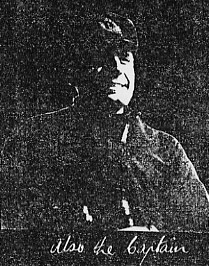 and married the former wife of the 4th
Baron Revelstoke before taking command of his first ship, HMS Venomous, in August. An uneventful six months followed but in January 1945 HMS Venomous
came close to being lost while anchored in Lunan Bay on the East coast
of Scotland when a NE gale rapidly developed into a hurricane. The
anchors dragged and the mast snapped off but Lawson took her out
through the
gap in the minefield to ride out the hurricane. While under repair at
Rosyth Derek Lawson handed over to Lt Cdr A. Guyon Prideaux. He
practised as a solicitor for a few years after the war and then retired
to manage his estate, Passenham Manor, in Northamptonshire.
and married the former wife of the 4th
Baron Revelstoke before taking command of his first ship, HMS Venomous, in August. An uneventful six months followed but in January 1945 HMS Venomous
came close to being lost while anchored in Lunan Bay on the East coast
of Scotland when a NE gale rapidly developed into a hurricane. The
anchors dragged and the mast snapped off but Lawson took her out
through the
gap in the minefield to ride out the hurricane. While under repair at
Rosyth Derek Lawson handed over to Lt Cdr A. Guyon Prideaux. He
practised as a solicitor for a few years after the war and then retired
to manage his estate, Passenham Manor, in Northamptonshire.
Lt Cdr A. Guyon Prideaux RNVR (1904- 1994) on the right was born in Colombo, Ceylon, the son of tea planter, but educated in England and practiced as a lawyer at the old established firm of Arthur Bright and Sons in London. In 1939 he walked up the gangplank of HMS President, the London headquarters of the RNVR at its berth on the Thame, and volunteered to join the RNVSR and his uneventful life suddenly changed. His humour and ability to get on with his fellow officers made up for lack of experience and after service on minesweepers and HMS Decoy he became a very competent "No 1" on the Hunt Class destroyer, HMS Beaufort, and took part in Operation Husky the landings in Sicily and in the chastening defeat in the Deodecanese, Germany's last significant naval victory. After service on HMS Lookout he became the last CO of HMS Venomous before it was scrapped and on the 12 May 1945 was sent to Kristiansand in Norway to accept the surrender of German naval forces. After the war he returned to his law firm in London. He never married and retired to the village of Longparish in Hampshire where he fished the River Test and "was an enthusiastic dancer of Scottish reels". The unpublished memoir of his wartime service is in the Library of the Royal Navy Museum at Portsmouth.
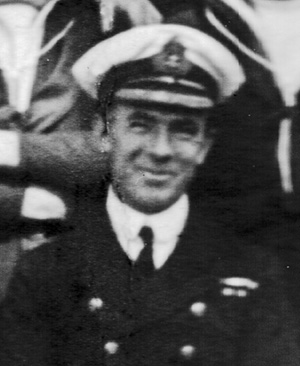
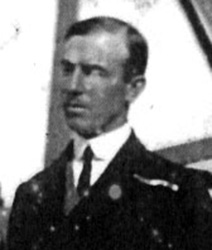 Cdr Somerville Peregrine Brownlow Russell RN (1883-1946)
Cdr Somerville Peregrine Brownlow Russell RN (1883-1946)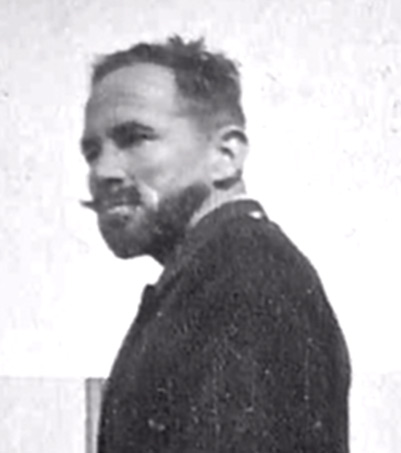
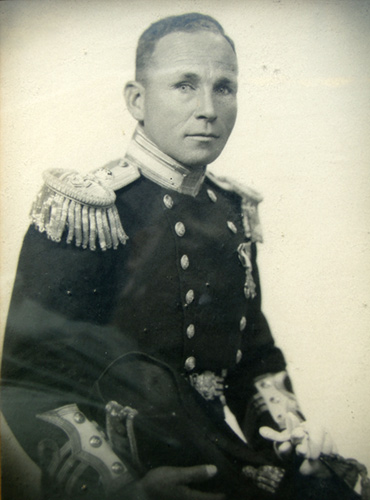 Lt Cdr Donal Scott McGrath RN (1891-1978)
Lt Cdr Donal Scott McGrath RN (1891-1978)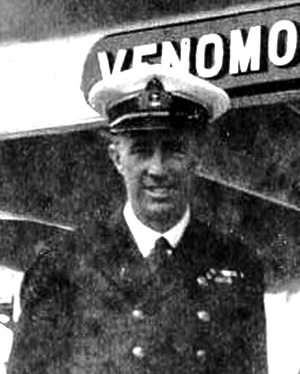 Lt Cdr Lawrence Frederick Nelson Ommanney RN (1891-1963)
Lt Cdr Lawrence Frederick Nelson Ommanney RN (1891-1963) Lt Cdr Edmund Gerard Noel Rushbrooke RN (1892-1972)
Lt Cdr Edmund Gerard Noel Rushbrooke RN (1892-1972)
The complete list of officers and men serving on HMS Venomous on specific dates during her three wartime commissions
have been extracted from the Pay and Victualing Ledgers and can be downloaded from this web site as PDFs
The ship's company of HMS Venomous on the 31 May 1940 at the height of the Dunkirk evacuation when John McBeath was the CO
The ship's company of HMS Venomous on the 12 November 1942 when HMS Hecla sank and Falcon-Steward was the CO
The ship's company of HMS Venomous on the 14 May 1945 after arrival at Kristiansand, Norway, to accept the surrender of German naval forces when Guyon Prideaux was the CO
Find out how to obtain service records for officers and men on HMS Venomous
